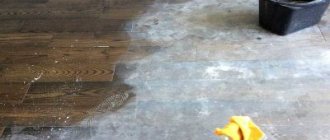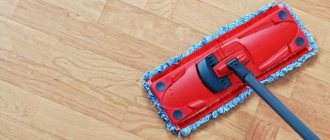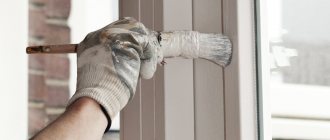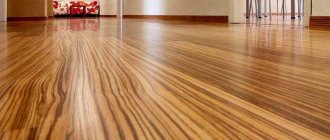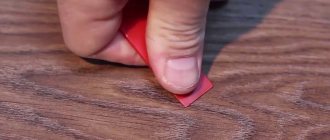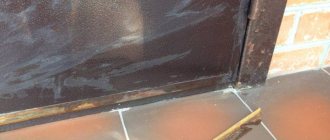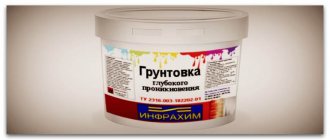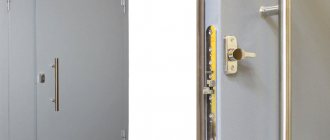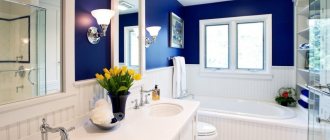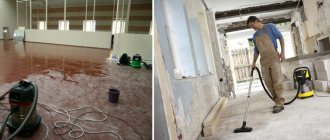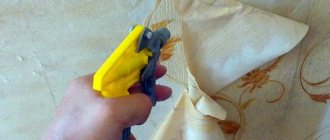Renovating one room in a residential apartment is perhaps the worst thing imaginable. But this is exactly what you often have to do. Already in the process of repair, no matter how hard you try to create less dust, dust lies in a thin layer everywhere, floating in the air. To minimize damage, try to keep the furniture covered with film or cloth at all times. They can then be washed/washed; cleaning furniture is more difficult. But the most tedious thing is to clean the floor after renovation, even if only dust has leaked into the rooms and there are no stains. No matter how much I wash it, it still appears again, again and again on the floor, with a white coating on all surfaces. We will tell you further how to solve the problem, how and with what to clean the floor after repair.
How to make cleaning easier after renovation?
How to clean whitewash from floors? There is a very practical belief that it is better to prevent a problem than to correct the consequences. To reduce the risk of coating contamination, do the following before starting work:
- Cover the floor with oilcloth or polyethylene.
- Attach it to the baseboards with masking tape.
Note: If this material is not available, use old newspapers or scrap rags.
These measures will help reduce the degree of contamination, but, unfortunately, painting dust will still settle on the surface over time, and the glue will leave sticky stains.
If you haven’t taken care of timely protection at all, then long-term cleaning is guaranteed. But even in this case, do not despair! In this article, we will give you some effective tips and recommendations on how to quickly clean a floor made of any material after renovation, without spending a lot of time and effort cleaning your home.
Washing linoleum
There are also always various traces of dirt on the linoleum that need to be eliminated. Washing linoleum is always carried out using clean warm water. In order to easily and efficiently wipe off all dirt, you need to constantly change the rag - otherwise the floor will be covered with stains, which are later quite difficult to get rid of (read: “How to wash linoleum from dirt - cleaning options”).
Soap is often added to water, which simplifies the process of washing linoleum. What you should not do is use soda - it has a negative effect on the surface of linoleum, significantly accelerating the process of fading.
If wet cleaning does not give the desired result, you can use one of the following methods:
By choosing one of these methods before washing the lime off the floor, you can ensure that all contaminants are effectively and reliably removed.
Conclusion
Cleaning a dirty floor after renovation is not the biggest problem. If you know how to clean floors after renovation without streaks and carefully clean the surface, then no problems will arise.
Source
How to clean the floor after renovation?
How to wash or clean concrete dust? To cope with such a difficult task as quickly as possible, you will need the following tools:
- water container;
- several rags;
- microfiber cloths;
- vinegar;
- salt;
- potassium permanganate;
- ammonia;
- kerosene;
- dishwashing detergent;
- Domestos;
- LOC Liquid Organic Cleaner from Amway;
- special floor cleaning products Mister Muscle and Mister Proper;
- laminate and parquet care products, for example, Laminate wash & shine;
- tile care products, for example, HG “Polish, wax and dirt remover”;
- Acidic floor cleaner DETERDEK.
In a separate article you will find a more detailed selection of suitable cleaning products after renovation.
General cleaning and post-renovation cleaning - what is the difference?
Cleaning after renovation differs significantly from general cleaning:
It is more painstaking and time-consuming, because first you need to get rid of construction waste.- The amount of work increases significantly, even if minor repairs were not carried out in all rooms. After all, no matter how you protect other rooms from construction dust, it will still fly away.
- Cleaning after renovation must be properly organized; it may take more than one day. Sometimes a professional approach is even required.
- After repairs, a lot of complex contaminants always remain. Therefore, you will need special cleaning agents and detergents, different for each type of material.
You can contact cleaning companies that provide professional cleaning assistance. If you decide to do this work yourself, then use the helpful tips below.
How to clean an apartment after renovation and white residue on the floor?
The general outline of your cleaning actions will look like this:
- Clear the area for cleaning: remove furniture and belongings.
- Use a damp broom to collect large debris into trash bags.
- Sweep or vacuum the floor to remove dust.
- Use a cloth soaked in warm water to wash off any major dirt.
- Let the base dry.
- If there are stuck pieces of cement, putty, or whitewash on the floor, take a spatula and carefully try to scrape off the top layer of such stains.
- Wet the remaining marks thoroughly with water to acidify them, then carefully remove them with a rag.
- Start mopping the floor from the far corner towards the exit using a raking motion.
- Rinse the mop (rag) thoroughly and often.
- Twist the rag well so as not to apply excess moisture to the decorative coating.
- Change the water in the bucket as often as possible.
Note: Having tidied up the walls, think about their further design. We will give you many DIY wall decor ideas.
How to remove from different coatings?
There are many proven and effective methods that can return a surface stained with a solution to its original state. These are household chemicals and folk remedies: everyone has the components for them in their home.
From the floor
It is best to wipe off dried putty stains as dry as possible. You should be extremely careful if tiles are laid on the floor: there is a risk of scratching them. If dry cleaning gives an unsatisfactory result, any product with active acids (for example, Toilet Duck) will help wash the surface. We read the composition: we find hydrochloric or any other acid in it.
If not, calmly continue washing:
From the door - wooden and metal
In some cases, areas of contamination can be wetted with water and then treated with a sponge and detergent. Any whitish stains that appear can be easily removed with citric acid: pour a little powder into the washing water.
From the tiles
Iron scourers for dishes are useful, as well as a product with acid or alkali - intended for cleaning ovens or plumbing fixtures.
When all contaminated areas have been wiped off, wash off the remaining solution and dirt:
From the car panel
Car puttying is one of the body repair processes.
Car owners are very concerned about the condition and appearance of their steel horses. The question “how to remove putty from a panel” is a common question on car forums. In the fight against any contamination, the time factor is important: the longer the stain of the solution remains on the car, the more difficult it is to remove it.
From wallpaper
Putty dust has a negative impact on health: it settles in the respiratory system, causing coughing and pain in the lungs. We must not forget about personal protective equipment.
How to clean the floor from construction dust?
There are several ways to clean whitewash from a floor, all of them have been tried and tested by more than one specialist. Choose the one that is more suitable for you depending on the type of decorative covering on the floor.
Method 1
To wash off traces of whitewash from the floor, use vegetable oil:
- Make an oil solution in a bucket of warm water in a ratio of 1:100.
- Wash the floor thoroughly.
- Replace the water, add 100 grams of vinegar to it.
- Rinse with this solution.
- Rinse off the solution with clean water.
Note: Vinegar can be replaced with any chlorine-containing product.
Method 2
To clean limescale, use regular kitchen salt:
- For the first time, wash the floor with a warm solution of water and dishwashing detergent: 1 tbsp. funds for a bucket of water.
- Second time with a salt solution: add ½ cup of salt to a bucket of water.
- If traces of whitewash still remain, add 100 ml of table bite to the saline solution.
- Finish the process by wiping with clean water.
Method 3
If the contamination is very serious, use potassium permanganate:
- Dilute potassium permanganate in water until it turns bright pink.
- Wipe the floor with the solution.
Note: Do not use this method on varnished surfaces - streaks will remain.
Method 4
Dirt that has become ingrained after repairs can be easily washed off using kerosene:
- Add 100g of kerosene to a bucket of water.
- Wash the floor.
- To remove the smell, dilute 200 ml of vinegar in a bucket of clean water.
- Wipe the floor with the solution.
Method 5
To remove old whitewash from the floor, use Domestos Pine Fresh universal cleaner:
- Dilute the product in water in a ratio of 50 ml per 5 liters of water.
- Wash the floor with the solution.
- Wipe the surface several times with clean water.
Method 6
To deal with stains after repairs, use special detergents designed for floors: Mr. Proper and Mr. Muscle. They will make your floor clean and fill the room with fresh aromas. They can be diluted in water and not removed from the decorative coating additionally after the main wash with clean running water.
Note: Please read the instructions carefully before use to ensure correct proportions.
Method 7
This product is suitable for all floor coverings - a universal concentrate from Amway LOC:
- Pour water into the container.
- Add concentrated product to it in a ratio of 1:200.
- Wash the floor with the solution.
- No need to rinse off.
- Repeat the process if necessary.
Method 8
Use a special product designed for cleaning gypsum dust PROBEL; it is also recommended for cleaning whitewash works. It is sold in all hardware and construction stores.
Apply it like this:
- Dilute 10 ml of product per 1 liter of water.
- Apply to coating.
- Rinse with water.
Removing repair dirt from various types of floor coverings
We have described how to clean a floor after renovation, but now it is important to consider which of the described methods are suitable for use on a specific floor covering.
Parquet
The choice of cleaning method for parquet after repair depends on the type of blockage. Regular repair dust and stains from lime or putty can be easily removed with water. To be sure of the result, you can add a little of your favorite detergent to the water, which is used for routine cleaning of the house.
If there are traces of glue, primer or paint left on the parquet after the repair, you will have to work a little to remove them. Here are some effective recommendations when working with parquet flooring:
- Before you wash parquet after repair with one or another product, you need to test it on a small area of the floor (somewhere under furniture or carpet) in order to avoid damage to the top layer of coating.
- When removing ingrained dirt, you must use extreme caution using solvents and other aggressive agents that can render the parquet unusable.
- Apply cleaning products directly to stains for a short time. By leaving the product on the parquet for a long time, you can get rid of stains from building materials, but at the same time create new ones - from the detergent itself.
- To remove dirt from parquet, it is best to use aqueous solutions with kerosene, methyl alcohol (can also be used in its pure form), or white spirit solvent.
It is also important to know what is unacceptable to do when cleaning dirt from parquet:
- Use scrapers, hard brushes, and a metal mesh for cleaning and washing. All these means can spoil the varnish with which the parquet is covered, thereby worsening the appearance of the coating and depriving it of its properties and qualities.
- Since parquet is not very friendly with water, there is no need to fill stubborn stains with water and leave them for a long time.
- Do not use cleaning products containing abrasive particles.
- Do not use aggressive solvents.
It is better to remove stains from building materials one by one rather than deal with them all at once.
After removing the stains, the entire surface of the floor can be washed with one of the products described in the first section of the article (a solution with vegetable oil will add shine and will remove stains well), and then wipe dry with a soft cloth.
Laminate
Just as in the situation with parquet, before washing the laminate after repair, you need to determine the type of contamination. Let's look at ways to get rid of stains from the floor:
- Dried polyurethane foam can be removed from a laminate-covered floor using a pharmaceutical product such as Dimexide. Apply it directly to the problem area and leave for a few minutes. After this, the foam can be easily removed with a spatula, rag or soft sponge.
- It is best to remove dried paint from laminate flooring with white spirit. To do this, moisten a cloth or cotton pad with solvent and quickly rub the stain.
- Bitumen stains can be easily wiped off with car care products.
- Dried stains of mortars can be easily removed with a plastic spatula, and then wiped with any of the solutions described in the first section of the article.
Attention! Laminate flooring, just like parquet flooring, must be handled with care; do not use abrasive cleaners, solvents, hard brushes or spatulas, so as not to damage the top layer of the coating.
It is advisable to wash laminate flooring with slightly damp cloths, since this coating is resistant to water.
You can also complete cleaning after renovation in rooms with laminate flooring using water with the addition of vegetable oil, after which there will be no dust or streaks.
Linoleum
To the list of means for cleaning linoleum after repair, in addition to the solutions described above (with the exception of kerosene), you can add such means as turpentine, laundry soap and chalk powder. The technology for cleaning dirt from linoleum is similar to cleaning parquet and laminate.
Attention! To clean linoleum, in addition to kerosene, it is not advisable to use soda, ammonia and gasoline, since not all types of linoleum are resistant to their effects and can be damaged.
Stains on linoleum can be filled with water, since this material is characterized by high moisture resistance. So, soaked putty, plaster or lime can be simply removed with a wet rag.
Tile
You don’t have to worry too much about the question of how to clean the tiles on the floor after renovation, since they are durable, moisture-resistant, and can withstand treatment with household chemicals and abrasive mixtures.
It is from a tiled floor that it is easiest to remove stains and dirt. Metal mesh and sponges, sponges with a fairly hard back, spatulas, knives and blades (to remove paint stains and dried construction mixtures) can be used.
To clean tiles, you can use alkaline and acidic agents, which will completely cope with any type of contamination after repair.
After all stains have been removed from the tiles, you can wash the entire surface of the floor with the following solution: mix 50 ml of vinegar (table), soda (soda ash) and any detergent in 7-8 liters of water. You can use this product not only after renovation work in the room, but also simply to maintain cleanliness in it.
Knowing how to clean the floor after renovation, the problem of removing dirt becomes less scary. Moreover, all the described products for various coatings are budget-friendly and quite simple to prepare and use.
How to wash the floor after painting?
If you have a painted wooden floor, use a solution of water and ammonia:
- For 1 liter of water add 1 tbsp. ammonia.
- Wash the floor with this solution.
- If you want the wooden surface to shine, additionally wipe with a cloth soaked in linseed oil.
To remove paint stains from a painted floor, use alcohol:
- Soak a cotton swab in alcohol.
- Apply to the stain for a few seconds.
- Take a spatula and carefully peel off the paint.
Note: If the paint stains are extensive, dilute ammonia in water and rub the contaminated areas.
For high-quality cleaning of whitewashed floors, use DETERDEK acid floor cleaner. It removes construction dirt and limestone traces from all surfaces.
The principle of its application is as follows:
- Dilute, depending on the degree of contamination, in a ratio of 1:5 to 1:10.
- Spread the substance over the floor using a rag.
- Leave for a few minutes
- Rinse off with plenty of water.
Note: To restore shine and shine to the old coating, wash it with a mixture of milk and water in a 1:1 ratio.
Available means
The fight against dirty floors can be made easier using proven folk methods. But before using them, it is recommended to test the solutions on inconspicuous areas of the coating.
Kerosene
In order to wipe off whitewash that has become particularly ingrained into the coating, use kerosene:
- Stir 150 ml of kerosene in 5 liters of water;
- Rinse the floors thoroughly with the resulting solution several times;
- then go over with a weak solution of vinegar, it will eliminate the kerosene smell;
- Wash the floors with clean water and ventilate the room.
Heavily dirty areas can be rubbed with a sponge dipped in clean kerosene.
Lemon
This method is good because it does not leave an unpleasant odor , as is the case with kerosene or vinegar:
- Add juice from half a lemon and 20 g of citric acid to 10 liters of warm water, stir until the grains are completely dissolved;
- wash the floor thoroughly;
- If necessary, repeat the procedure by making a new lemon solution.
Salt
This method involves using regular rock kitchen salt (not “Extra”):
- Thoroughly dissolve 5 tablespoons of salt in 10 liters of warm water so that no grains remain. Add 2-3 teaspoons of liquid soap or dishwashing detergent. Stir.
- Wash the floor thoroughly with the resulting solution.
- Now rinse the surface with water and 1-2 tablespoons of vinegar to remove traces of salt and soap.
- The final stage is washing the floor with clean water and ventilating the room.
Vinegar
You will need 3% vinegar, you can use regular table or apple vinegar:
- Dilute 4 tablespoons of vinegar in 10 liters of water.
- Do not wring out the cloth soaked in the resulting solution, and wash the floors with it.
- If the floor is not clean enough after drying, repeat the procedure, but with less vinegar (2 tablespoons).
- Ventilate the room thoroughly.
How to clean linoleum after repair?
All of the above methods are suitable for linoleum-covered floors. Let's add a few more useful tips on caring for this decorative material.
Note: When cleaning linoleum, do not use such products as ammonia, gasoline and alcohol.
Method 1
Dirty embossed linoleum is much more difficult to clean, unlike other types. It is ideally washed with a massive washing vacuum cleaner. With this approach, you can easily clean the coating from whitish spots.
Method 2
To return linoleum to its original appearance if it has darkened, use drying oil:
- Apply the product to a rag.
- Wipe the coating thoroughly.
- Rub with a dry woolen cloth.
How to remove plaster, traces of whitewash
It is better to wipe off dried plaster stains as dry as possible. If there are tiles on the floor, just scrape it off with something, but try not to scratch it. For softer surfaces—linoleum—soak with acidified water (add vinegar) and scrub off little by little. If it is too difficult, any product with active acids will help to clean the floor. Among the most affordable are Toilet Duckling and similar products for the toilet or bathroom. But first read the composition - hydrochloric or any other acid should be indicated there. Just don’t try it on linoleum, parquet or laminate. Most likely, the coating will be damaged. If there is scrap material, test the product on it. After testing, is there any damage or discoloration? Try cleaning the plaster from the floor with this product.
How to wash linoleum after repair - with simple means: water + vinegar + dishwashing detergent
To clean the floor from putty or plaster, first try diluting a capful of the found acidic product in a small amount of water (a liter or one and a half). Apply the solution to the stain and wait a few minutes. Let's try to scrub it off. It helped - great. No, we're trying to increase concentration. Particularly persistent ones can be treated with an undiluted product. But if it doesn’t help, most likely you need to look for another remedy.
You can try softening plaster or putty stains with kerosene. Drop a couple of drops and wait, then try to wipe it off. But remember that it is better not to apply kerosene to laminate and linoleum.
When working with acids or kerosene, try to breathe “to the side.” Literally. The acid and kerosene evaporate and the vapor enters the lungs and can cause severe coughing. If you breathe long enough, it can even cause poisoning. In general, open the windows, ventilate and be careful. Whitewash, putty and other repair compounds are removed in the same way.
How to clean a laminate floor after renovation?
Laminate is a very common type of coating these days. The laminated board is covered with a thin layer of fibrous material impregnated with thermosetting resins. This makes it heat-resistant, impact-resistant, and resistant to long-term loads, but, despite all these qualities, it requires careful handling and some care.
Option 1
The easiest way is to use a solution of water and vinegar:
- Dilute vinegar in a bucket in a ratio of 1 tbsp per 5 liters of water.
- Wipe the surface with this solution.
- Rinse off with clean water.
Option 2
Use special laminate care products - they wash and add shine to the coating, and also have a fresh smell:
- Make a solution in the proportion of 100 ml of Laminate wash & shine to 10 liters of warm water.
- Wash the surface with this solution using a microfiber cloth; it absorbs moisture well and cleans perfectly.
- Make sure that the rag is not very wet to avoid deformation of the coating.
Note: do not wash off the solution.
Video description
How to clean linoleum from construction dust.
Linoleum
This floor covering is not afraid of moisture, so it can be easily processed using a washing vacuum cleaner or mop. For cleaning, you can use household solid or liquid soap, special floor cleaners, vinegar, table salt, sodium permanganate.
These products are considered absolutely harmless. Just before cleaning, they must be properly mixed with water, otherwise even more stains will occur. It should be noted that gasoline, peroxide, and any types of alcohol and solvents are prohibited. They are capable of eating away the pattern on the linoleum covering.
Also, for this type of coating, various compositions of household chemicals are often used. Just before using them, it is recommended to study whether the selected composition is suitable for finishing, and how to properly dilute it before use.
How to clean parquet after renovation?
Parquet boards are afraid of moisture, so it is not recommended to wash parquet; usually it is wiped with a barely damp cloth. But if there is such a need, use special parquet care products for cleaning. For example, Parquet wash & shine. This product is used for varnished parquet.
When cleaning, follow this sequence of actions:
- Vacuum the surface with a special attachment that has soft wheels.
- Make a solution of 100 ml of product per 10 liters of warm water.
- Soak a regular floor cloth in the solution or use a special HG “Natural fiber floor cloth” cloth.
- Before mopping the floor, wring out the cloth and make sure it is not very wet.
- Wash the floor.
- After treatment, do not rinse or dry the surface - the product covers the floor with a special film and gives the surface shine.
In order to remove paint stains from parquet without a varnish coating, we offer several options:
- Option 1: Use regular cream.
- Apply the cream to a rag.
- Gently rub the stain.
- Try some cologne.
Parquet cleaning
Before you wash the parquet after repair, you must first find out what type of contamination you are dealing with - the method of cleaning the surface will depend on this.
Common water-soluble dirt (putty, whitewash) can be removed with plain water and a small amount of detergent. That is why special preparation and long thoughts about how to wash putty from the floor are not required. In addition, the use of water to wash away dirt in the case of parquet is also justified for the reason that parquet is not afraid of moisture and is excellent for wet cleaning.
It will be much more difficult to deal with paint or glue that gets on the parquet.
Here you will have to use the following recommendations:
In addition to methods for washing dirt on parquet, you need to know what methods of exposure to this floor covering are prohibited:
How to clean floor tiles after renovation?
To remove lime deposits from tiles, use a special HG “polish, wax and dirt remover” tile care product.
Note: It protects the floor from the appearance of new stains and greatly simplifies the cleaning process.
The way to use it is very simple:
- Dilute 100g of product into 10 liters of water.
- Wash the floor, constantly rinsing the cloth.
- Change the water when it gets dirty.
- Do not rinse the floor to avoid removing the layer of shine.
Tools for removing old putty
In order to completely remove the old putty, certain tools and auxiliary materials are used. In this case you can use the following:
- 646 is a solvent that perfectly corrodes all remnants of paint and varnish coatings and building mixtures.
- A spatula that can be used to remove excess material present from a specific surface.
- Often the surface is treated with hot water (this allows you to eliminate excess immediately after contact).
- A rag with hard bristles, as well as appropriate metal brushes, will help to remove any remaining substance.
- To clean the surface, you can use a utility knife, and also construction tape to protect the surface around the stain.
- Additionally, you can use gasoline, as well as concentrated soap solution and special chemicals.
In each individual case, the cleaning process, as well as the tool and material used, directly depend on the structure of the coating and the period that has passed since the substance entered the coating.
Important. In the process of carrying out the relevant work, it is necessary to correctly follow the cleaning technology so as not to damage the integrity of the entire base through incorrect actions.
Useful tips
- To achieve a good result in cleaning whitewash from the floor, try to change the water more often.
- Do not let the paint dry on the surface, try to remove it immediately.
- When using strong-smelling products, work in a well-ventilated area.
- Work in special clothing and protective gloves.
By adhering to the above rules for cleaning after renovation, you will be able to enjoy the work you have done to change the interior design and relax peacefully in a cozy home, rather than spending a lot of time on lengthy cleaning of all traces!
